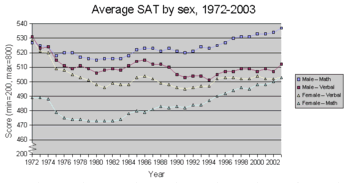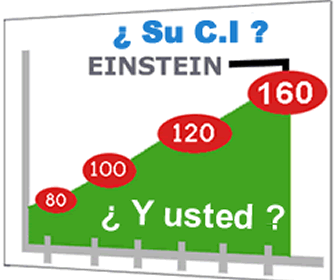Sex and intelligence (see also this article in Spanish)
Introdution:
Sex and intelligence research investigates differences in the distributions of cognitive skills between men and women. This research employs experimental tests of cognitive ability, which take a variety of forms, including written tests like the SAT. Research focuses on differences in individual skills as well as overall differences in general cognitive ability, which is often called g. IQ tests, which are specially designed to measure cognitive ability, usually test a variety of skills.
The population of men and women differ on average in how well they perform on some of these skill tests, but do equally well on other tests. For example, women tend to score higher on certain verbal and memory test, whereas men tend to score higher on spatial tests, particularly mental spatial rotations.
While these results are relatively uncontroversial, the question of whether men and women differ on average in g is a matter of debate among experts. Most studies unambiguously find that men as a population are more varied than women in g (i.e. there are more men than women at the extremes of ability). For instance, a 2005 study which was published in the British Journal of Psychology concluded that there are twice as many men with an above-average IQ of 125 than there are women, and also twice as many men with a below-average IQ.
However, determining whether men and women differ on average has been more difficult. It is easy to design an IQ test in which either males or females score higher on average, by selecting different tests or giving them different weights, so the question boils down to which weights the different tests should have for the g factor.
The primary reason for expecting that men will have higher average g than women is the male advantage in brain size. Resolving this question requires the use of sophisticated statistical techniques to extract g from the results of IQ tests. Some studies find an average male advantage in g, but most do not.
1- History
The scientific study of the differences in mental aptitudes between men and women dates back at least as far as the mid-nineteenth century, when the question of women's voting rights arose in a number of countries. In Victorian England, for example, the philosopher John Stuart Mill argued that there were no differences between men and women, whereas the scientist Charles Darwin (in his Descent of Man) argued that women were by their nature inferior in respect to mental ability. Many of these early attempts were based on anecdotal data. However, some scientists, such as Paul Broca (1861), attempted to derive empirical results from various forms of anthropometry, namely the comparison of brain mass. With the development of psychology at the end of the nineteenth century, and the evolving focus on intelligence testing in the early twentieth century, further attempts were made by a variety of scientists to examine the mental differences between men and women. Leta Hollingworth has argued that women were not permitted to realize their full potential, as they were confined to the roles of child rearing and housekeeping.
The findings have provoked controversy at various times, often because political implications were perceived to be attached to them. In the nineteenth century, as noted, whether men and women had equal intelligence was seen by many as a prerequisite for the granting of suffrage. In the late-twentieth century, whether men and women had different aptitudes is often taken to reveal whether disproportionate employment or payment of men is a form of sexism or simply a reflection of innate aptitudes
2- SAT scores
The SAT is a voluntary, standardised test taken by many American college applicants. It is administered by the Educational Testing Service, which keeps track of the gender of test-takers and releases SAT scores by gender. In 2001, men scored 509 out of 800 on the verbal portion while women scored 502 out of 800.
The difference, however, is more pronounced and consistent on the math segment of the SAT. In 2001, men scored 533 while women scored 498. This difference tends to appear year after year.

Allegations of SAT bias
Rosser (1989) claimed that there were four potential areas for testing bias in the SAT:
However, many of these hypotheses are difficult to test, and there is no direct evidence women's lower scores are due to any of these factors.
3- Other reports
A 2001 report by Richard J. Coley of the ETS found that females often outperformed males on various measures of verbal ability, while males tended to outperform females on measures of mathematical and spatial ability.
IQ and memory
A 1994 study by H. Stumpf and Douglas N. Jackson based on medical school application test scores showed that men averaged IQs about 8.4 points higher than women, while women averaged memories about 7.5 IQ points higher than men. This study, however, may be atypical.
A 1999 study by Richard Lynn, found that the IQ difference between men and women is typically about 3-4 IQ points, while women usually maintain short-term memory advantages over men of about 2 IQ points. In a 2005 study published in the British Journal of Psychology which attracted media attention in the wake of the January 2005 controversy at Harvard (below), he and Pal Irwing analyzed existing studies to report that men have an average IQ between 3.3 and 5.0 points higher than that of women; in Nature, intelligence-test designer Steve Blinkhorn argued in reply that Lynn and Irwing's analysis was critically flawed, for example by deliberately excluding a large contrary study that made up almost 45% of the subjects in the meta-analysis
Overall average and variance
Evidence against differences in overall average IQ scores between men and women comes from several very large and representative studies. However, these studies did find that the scores of men show greater variance than the scores of women, and that men and women have some differences in average scores on tests of particular abilities, which tend to balance out in overall IQ scores.
Deary et al. (2003) performed an analysis of an IQ test administered to almost all children in Scotland at age 11 in 1932 (>80,000). The average IQ scores by sex were 100.64 for girls and 100.48 for boys. The difference in mean IQ is not significant. However, the standard deviation was 14.1 for girls and 14.9 for boys. This difference was statistically significant. In the sample studied, 49.6% are girls and 50.4% are boys. Because of the difference in variance between the sexes however, girls are in excess by 2% in the middle IQ range of 90–115. At the extreme IQ ranges, 50–60 and 130–140, boys make up 58.6% and 57.7% of the population (a gap of 17.2% and 15.4%) respectively. That is, boys were overrepresented amongst the lowest and highest IQ groups.
Evolution over time
Hedges and Nowell (1995) performed a meta-analysis of national ability surveys that cover a 32-year period. Their primary conclusion is that male scores show greater variance (more men than women at the extremes of ability) in most abilities. The use of representative samples gives them reassurance that these differences in variance are true, and not the result of differential selection by sex. Their second finding is that average differences in most abilities are small. Exceptions include moderate to strong average advantages for men in math and science and typically male vocations, and moderate to strong average disadvantages to men in reading. They suggest the male advantage in measures of typical male vocations is not predictive, but that the other strong differences are. Thus, they claim to be concerned about the relative disadvantage of men in writing and the disadvantage to women in science and math. For example, they mention that male advantage in math and science may cause inequality in income between men and women and the underrepresentation of women in these academic fields, and likewise that men may suffer greater rates of illiteracy that will push more of them towards unemployment.
A recent report by the National Academies in 2006 found that female performance in high school mathematics now matches that of males, and expressed that if biology were the basis of the change, then major evolution has occurred in the past decades. In addition, the report found that there were lower numbers of women in the mathematics and science fields than there should be even when studies based on biological differences, childbearing demands, and hormonal differences were looked at. The report concluded that women were the subject of unintended bias in these fields.
Controversy
Another study performed by the American Psychological Association in response to the book The Bell Curve, which investigated the difference in intelligence between different races, determined (as did the authors of the book) that the studies available in 1995 showed no major difference between males and females in regard to IQ scores.
In January 2005, Lawrence Summers, president of Harvard University, unintentionally provoked a public controversy when MIT biologist Nancy Hopkins leaked comments he made at a closed economics conference at the National Bureau of Economic Research.In analyzing the disproportionate numbers of men over women in high-end science and engineering jobs, he suggested that after the conflict between employers' demands for high time commitments and women's disproportionate role in the raising of children the next most important factor might be the above-mentioned greater variance in intelligence among men than women, and that this difference in variance might be intrinsic, adding that he "would like nothing better than to be proved wrong".
The controversy generated a great deal of media attention, forced Summers to make a number of apologies, and led Harvard to commit $50 million to the recruitment and hiring of women faculty. In July 2006, Stanford University neurobiologist Ben Barres, a transsexual man, wrote a provocative piece in Nature on his own experiences as both a male and female scientist. Barres argued that prior to transition, he had succeeded as a female despite pervasive sexism. Barres cited numerous studies that show female scientists are consistently rated lower than their male counterparts with the same levels of productivity and credentials.
In 2006, Danish psychologist Helmuth Nyborg was asked to vacate his position at Aarhus University after publishing a paper in Personality and Individual Differences that showed an 8 point IQ difference in favour of men.
Other differences
- Memory: Several studies have shown women are better at certain types of memory.
- General knowledge: A study by Richard Lynn showed that men have more general knowledge than women.
- Education: In the United States, women tend to outnumber men at colleges and universities, except at technical institutions that emphasize math and science such as MIT and Caltech, where men predominate.
- Academia: Men outnumber women in tenured faculty positions in math and science. Women outnumber men in tenured faculty positions in humanities fields.
- High IQ societies: In many high IQ societies men outnumber women, e.g., in Mensa the male-to-female ratio is 2:1. However, these societies are self-selecting, with voluntary membership.
4- Brain size
In 1861, Paul Broca examined 432 human brains and found that the brains of males had an average weight of 1325 grams, while the brains of females had an average weight of 1144 grams. A 1992 study of 6325 Army personnel found that men's brains had an average volume of 1442 cm³, while the women averaged 1332 cm³. (Ankney 1992). The differences are smaller but persist when adjusted for body size (Ankey, 1992). Image: Side view of male and female human brains:

In 2005, Haier et al. reported that compared with men, women show more white matter and fewer gray matter areas related to intelligence. They also report that the brain areas correlated with IQ differ between the sexes. They conclude that men and women apparently achieve similar IQ results with different brain regions.
Although women may have smaller brains than men, they appear to have greater neuron density in their prefrontal lobe, which is involved in higher functions such as planning, judgement, and language, although men still have higher absolute grey matter volume than women in their prefrontal lobe.
5- Reasons for differences
It is possible that sexual dimorphism may exist in regard to intellectual abilities in humans. Men may have evolved greater spatial abilities, possibly as a result of certain behaviors, such as navigating during a hunt, that they were more likely to be involved in during humans' evolutionary history (Geary, 1998). Similarly, women may have evolved to devote more mental resources to gathering food, as well as understanding and tracking relationships and reading others' emotional states in order for them to be able to better understand their social situation (Geary, 1998).
Another possibility is the effects of socialization. Girls are sometimes discouraged from studying math or science. Similarly, boys are sometimes discouraged from displaying empathy, or from spending excessive time reading for pleasure. Thus, differences in intellectual abilities between the sexes may reflect which abilities each sex is more often encouraged to develop.
The above two hypotheses are not mutually exclusive; some combination of the two may be at work.

6- References
- Born, M. P., Bleichrodt, N. & van der Flier, H. (1987). "Cross-cultural comparison of sex-related differences on intelligence tests". Journal of Cross-Cultural Psychology
- Geary, D. (1998). Male, female: The evolution of human sex differences. Washington, DC: American Psychological Association.
- Haier RJ, Benbow CP. (1995). "Sex differences and lateralization in temporal lobe glucose metabolism during mathematical reasoning".
- Haier RJ, Jung RE, Yeo RA, et al. (2005). "The neuroanatomy of general intelligence: sex matters".
- Lynn, Richard, with P.Irwing and T.Cammock (2002). "Sex differences in general knowledge". Intelligence
- Lynn, Richard (1999). "Sex differences in intelligence and brain size: a developmental theory". Intelligence
- Stumpf, H. and Jackson, D. N. (1994). "Gender-related differences in cognitive abilities: evidence from a medical school admissions program". Personality and Individual Differences
- IJ Deary, G Thorpe, V Wilson, JM Starr, LJ Whalley (2003). "Population sex differences in IQ at age 11: the Scottish mental survey 1932". Intelligence
- Larry V. Hedges; Amy Nowell (1995). "Sex Differences in Mental Test Scores, Variability, and Numbers of High-Scoring Individuals". Science
- Nyborg, Helmuth (2005). "Sex-related differences in general intelligence g, brain size, and social status". Personality and Individual Differences
- Wikipedia, the free encyclopedia
Test de inteligencia Oficial:
+ 50 preguntas
+ Duración 45 min.
+ Resultados fiables
+ Tarifa: 3,00 EUR >>acceder
Mini test para practicar:
+ Gratuito
+ 10 preguntas
+ Duración 7 min. >>acceder




